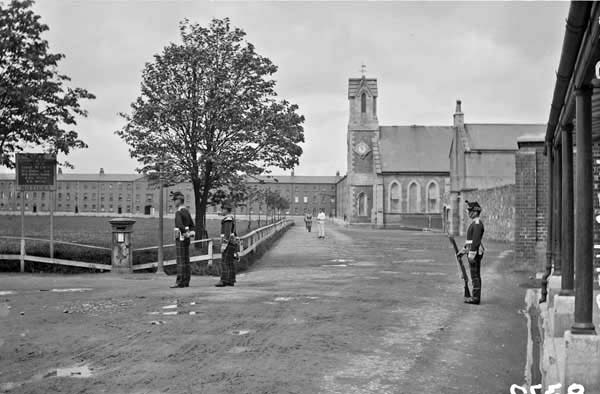Watching this photo montage 1 of the last wedding in Mullingar’s garrison chapel, St Barbara’s, prompted some questions I have (sort of) answered and others that will have to wait for another day.

Source: National Library of Ireland, catalogue.nli.ie/Record/vtls000332062 (Accessed 16 March 2012).
The Irish Times photos show the church quite clearly, in particular the date it was built– 1855 – on the pennant on the chapel roof. Interesting, I thought, why was it built some decades after the main complex, which opened to troops in 1817? So I went to the invaluable National Inventory of Architectural Heritage to check if the chapel was considered aesthetically significant. Yes, St Colman’s chapel, Mullingar Barracks is listed.
‘Freestanding nine-bay military chapel, built c.1855, having attached three-stage belltower attached to the entrance front (south). Originally in use as a Church of Ireland church but now in use as a Roman Catholic church.’ 2
So St Colman’s became St Barbara’s after 1922. Of course, any church built in 1855 with the imprimatur of the British government could only be Anglican. This church building had been transferred, through the British and Irish governments, from one Christian denomination to another.
But how does that work? The standard historical narrative of Ireland polarises the Protestant and Catholic relationship, because it focuses on the political aspirations of Nationalists and Unionists. Irish, English, Catholic, Protestant, Nationalist, Unionist: look at all those important communities, all with their powerful capital letters too. So how do the Catholics/Nationalists (newly independent but fundamentally unhappy about the form of the independence) take over a building that embodied the Protestant/Unionist project?
I (foolishly) presumed that the garrison church must have been changed from an Anglican to a Roman Catholic place of worship immediately after 1922. But this didn’t happen in Dublin Castle, where the Chapel Royal was not taken over by the Irish Army for Catholic religious services until 1943. Mass was celebrated in June 1943 after the church had been blessed, but not ‘solemnly consecrated’ by the Archbishop of Dublin, John Charles McQuaid. 3 Clonmel garrison church had an ignominous post-independence period, being used as a printing shop in the 1930s and 1940s. South Tipperary Military History Society claim it was reconsecrated on 8 November 1956 but it was already in use for Catholic services in May 1956, when a Mass was celebrated to to mark the 138th anniversary of the birth of Charles Kickham. 4 On the other hand, Cork garrison chapel was ‘solemnly blessed’ by Bishop of Cork Daniel Cohalan in June 1923, who declared that ‘the Irish National Army was the Army of the most Catholic nation in the world’. It appears that the decision to use the Cork chapel for Catholic services was taken very shortly after the National Army took over the barracks.
So what happened to Mullingar chapel? I still don’t know when and why it became the garrison chapel for Columb Barracks and the Irish Army. I do know that St Colman (a saint associated with the origin myth of the town itself) was replaced by St Barbara, the patron saint of artillerymen internationally, and incidentally, the patron saint of the British artillery. 5 The new dedication honoured the function of the artillery barracks while the previous devotion had inextricably tied the garrison chapel to the town. Intriguing but there is still so much to know.
So what was the Irish Army’s policy on religious worship within the barracks? And what was the difference between ‘solemnly blessing’ and reconsecrating a chapel? I will be returning to the curious case of Mullingar garrison chapel, and the other garrison chapels, again. And if I can find a theologically minded person who can shed light on blessing/consecration aspect, there will be a guest post!
- http://www.irishtimes.com/indepth/slideshows/columb-barracks-wedding/ (Accessed 16 March 2012). ↩
- http://www.buildingsofireland.ie/niah/search.jsp?type=record&county=WM®no=15310008 (Accessed 16 March 2012). ↩
- ‘Mass celebrated in the former chapel royal’ Irish Times, 14 June 1943. ↩
- Information Pack produced by Soth Tipperary Military History Society downloaded from http://www.stmhs.ie/#/kickham-barracks-memorials/4557885875 (Accessed 16 March 2012). Mass for Kickham described in Irish Independent, May 25 1956, p 9. ↩
- http://www.firepower.org.uk/about/the_regiment.asp (March 13, 2012) ↩